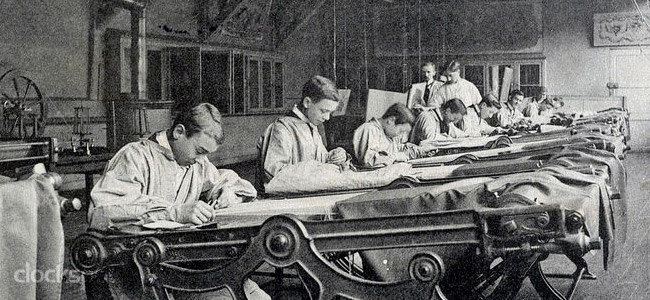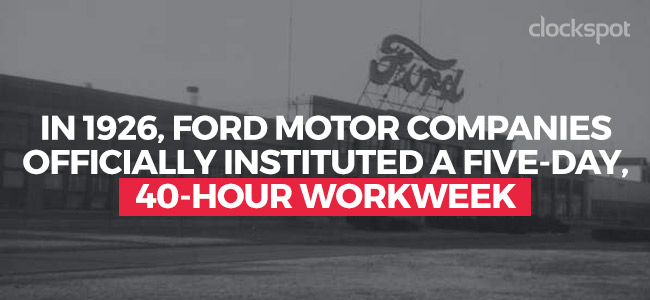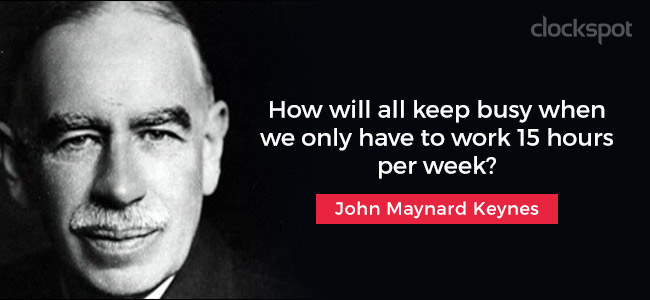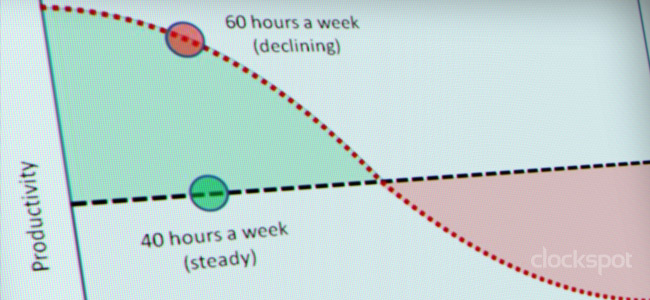A central part of the American Dream is the 40 hour workweek. You graduate from college and get a standard 9-5 job. You punch in, do your job, and then go home at the end of the day to spend a restful evening with friends and family. After 30 years of working the 9-5, you retire and spend your days playing golf or hiking or puttering around in your garden.

This process is embedded deeply into American folklore. Immigrants come to United States and are willing to work excruciating hours so that their children might be able to only work 40 hours per week. The country band “Alabama” performed a song entitled “40 Hour Week (For A Livin’)”, which was a salute to America’s blue-collar workers. The song included the stirring words:
Hello Detroit auto workers, let me thank you for your time. You work a forty hour week for a livin', just to send it on down the line. Hello Pittsburgh steel mill workers, let me thank you for your time. You work a forty hour week for a livin', just to send it on down the line
WARNING!
An employee is stealing from you.
Download our free ebook to eliminate your risk.
Most salary jobs pay on the basis of a 40 hour work week with anything over 40 hours being overtime.
Of course, this raises several crucial questions.
- How did the 40 hour work week originate?
- Do most people really only work 40 hours per week?
- Is the 40 hour workweek ideal?
[Tweet "Most salary jobs pay on the basis of a 40 hour work week with anything over 40 hours being overtime."]
In this post, we’re going to answer all three of these questions. By the end, you’ll be a 40 hour work week genius.
Ready? Let’s go.
The Origins Of The 40 Hour Work Week
Working 40 hours per week wasn’t always the norm. The government first began tracking work hours in 1890, and they determined that the average workweek for most employees was 100 hours! That works out to a 14.5 hour day, 7 days per week. Talk about a grueling and exhausting schedule.

The extensive, grueling workday was primarily the result of hard-driving employers who wanted to squeeze maximum productivity out of their workers.
In 1866, the National Labor Union asked Congress to mandate an eight-hour workday, but their request was denied.
In 1867, the Illinois Legislature passed a law restricting the workday to only 8 hours. Employers were incensed and refused to cooperate, resulting in a massive employee strike in Chicago.
In 1869, President Ulysses S. Grant issued a proclamation which ensured that all government workers would receive a steady wage and only work eight hours per day.
Whereas the act of Congress approved June 25, 1868, constituted, on and after that date, eight hours a day's work for all laborers, workmen, and mechanics employed by or on behalf of the Government of the United States, and repealed all acts and parts of acts inconsistent therewith:
Now, therefore, I, Ulysses S. Grant, President of the United States, do hereby direct that from and after this date no reduction shall be made in the wages paid by the Government by the day to such laborers, workmen, and mechanics on account of such reduction of the hours of labor.
In 1886, labor organizations banded together and called for a national strike supporting a shorter workday. Over 300,000 workers joined the strike across the country, and in Chicago demonstrators and police officers violently clashed.
In 1906, an eight-hour workday was finally instituted at two large companies in the printing industry.
In 1916, Congress passed the Adamson Act, which established an eight-hour workday for interstate railroad workers. The Supreme Court then constitutionalized this act in 1917.
In 1926, Ford Motor Companies officially instituted a five-day, 40-hour workweek.

In 1938, Congress passed the Fair Labor Standards Act, which nationally limited the workweek to 44 hours.
Finally, in 1940 Congress amended the Fair Labor Standards Act, setting the workweek to a maximum of 40 hours.
The auto workers in Detroit may work 40 hours per week now, but it wasn’t always this way. Up until 1938, many workers put in 60, 70, and even 100 hour per week, breaking their backs to provide for their families and keep their jobs. Anyone who has read The Jungle, a scathing expose of the meat industry in the early 1900’s by Upton Sinclair, knows just how brutal working conditions could be.
Thankfully, most of us don’t have to deal with conditions like that anymore.
Or do we?
Do Most People Only Work 40 Hours Per Week?
In 1930, economist John Maynard Keynes predicted that Americans would soon only be working 15 hours per week. He asked, “How will all keep busy when we only have to work 15 hours per week?”

If only Keynes had been right.
Unfortunately, the 40-hour work week is quickly becoming a quaint relic of the past. A recent study by Gallup shows that most adults report working 47 hours per week, which amounts to almost a full extra day in a 40-hour week. On top of this, 40% of workers report that they work at least 50 or more hours per week.
Part of this increase in hours can be attributed to salaried positions. These workers don’t receive overtime pay and simply must work until the job is done. This explains why full-time salaried workers work an average of 49 hours per week compared to full-time hourly workers who only work 44 hours per week.
Another factor in the surging hours may be that long hours are often seen as a status symbol. As Harvard Business School professor Robin Ely says:
There is something almost appealing to being available 24/7. Being in demand is a symbol of status. It suggests you're important and influential.
Additionally, the dramatic explosion of digital information and the time required to manage it is forcing workers to spend additional hours on the job. A recent survey indicated that American workers spend up to 6.3 hours every day checking and managing email. Assuming that half of that time is spent on personal emails, that’s still 15 hours per week spent managing work-related emails. The only way to spend this amount of time checking email and also complete all other job-related tasks is simply to work more hours.
The bottom line is that Americans are working more than ever. As Shana Leibowiz wrote in Business Insider:
Americans have it particularly bad: 58% of managers in the US reported working over 40 hours a week. The only country where people work longer hours is Mexico, where 61% said the same.
Compare that to China, where just 19% of managers said they work over 40 hours a week.
Is The 40-Hour Workweek Ideal?
Actually, the 40-hour work week is just about right. Granted, this can’t be insisted upon dogmatically, with numerous countries working less hours per week than America. But studies have shown that working around 40 hours maximizes productivity. In his book Rules of Productivity, Daniel Cook shows how over a 1 month period, productivity significantly drops after working more than 40 hours in a single week.

He says:
In a 60 hour crunch people have a vague sense that they are doing worse, but never think that they should stop crunching. They imagine that working 40 hours a week will decrease their productivity. In fact, it will let them rest and increase their productivity.
This makes sense at an instinctual level. Once you reach a certain point of mental and physical fatigue, your productivity dramatically falls. You may feel like you’re accomplishing something, but there’s a good chance you’re not. And you may have a sense that you’re a star employee, but you would actually serve your company more effectively if you went home and got some rest.
As Sara Robinson wrote in Salon:
By the eighth hour of the day, people’s best work is usually already behind them (typically turned in between hours 2 and 6). In Hour 9, as fatigue sets in, they’re only going to deliver a fraction of their usual capacity. And with every extra hour beyond that, the workers’ productivity level continues to drop, until at around 10 or 12 hours they hit full exhaustion.
In other words, by the time you hit the end of the day, your brain and body are shot. Every additional hour only yields fractional returns in productivity. Rather than trying to jam extra hours in the day, you would be wiser to focus on increasing productivity during your peak hours (hours 2-6).
Some companies, particularly in countries like Sweden, are beginning to see the value of a shorter work week. For example, Linus Feldt, the manager of an application development company, said:
I think the eight-hour workday is not as effective as one would think. To stay focused on a specific work task for eight hours is a huge challenge…In order to cope, we mix in things and pauses to make the workday more endurable. At the same time, we are having it hard to manage our private life outside of work. We want to spend more time with our families, we want to learn new things or exercise more. I wanted to see if there could be a way to mix these things.
The Solution?
It would be easy to say that the solution is simply to work fewer hours. But try strolling into your boss’s office and informing him that science has proven you must cut your hours down to exactly 40 every week. There’s a good chance you’ll leave his office without a job.
However, there are actions you can take to cut down on the number of hours you work every day. Minimizing workplace distractions allows you to use your peak hours on difficult projects. Spending less time doing email and social media can also improve your hours. Finally, you can stop seeing long, grueling hours as a badge of honor and begin prioritizing true productivity.
Andrew Wilkinson, founder of MetaLab, says:
You don’t have to make yourself miserable to be successful. It’s natural to look back and mythologize the long nights and manic moments of genius, but success isn’t about working hard, it’s about working smart.
We fully agree.